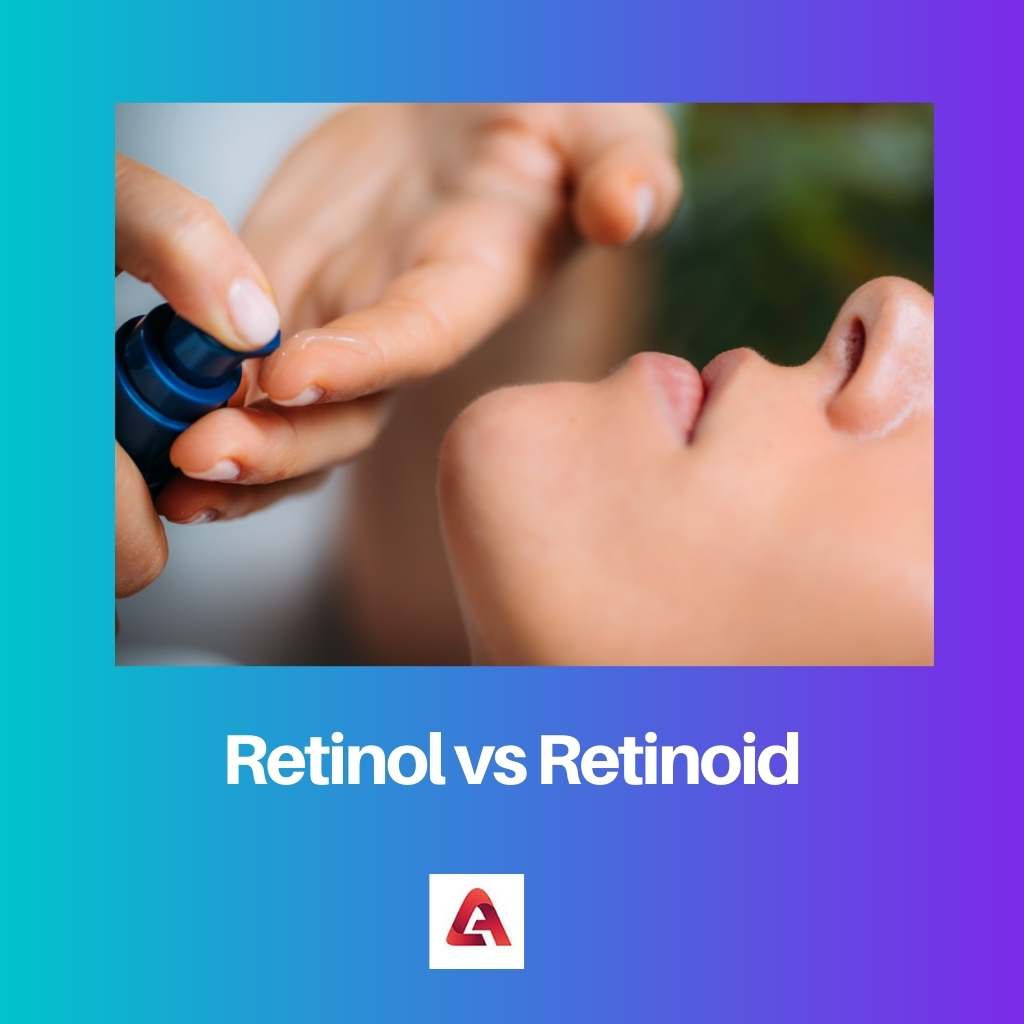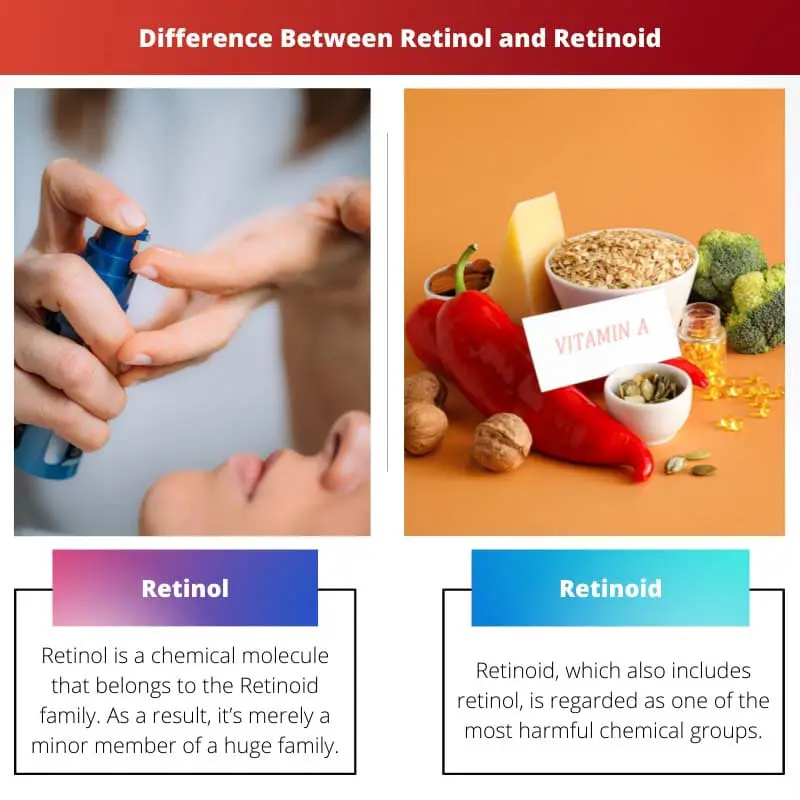A lot of chemicals are found in cosmetics that are highly dangerous for the skin. However, some chemicals are there which are skin-friendly.
Retinol, Retinoid, and Retinoic acid are some of the names of skin-friendly chemicals. However, Retinoid and Retinol are used interchangeably often.
These two chemicals are highly popular when the manufacture of food supplements and skin care products is taken into consideration.
Key Takeaways
- Retinol is a form of vitamin A found in animal products, while retinoids are synthetic compounds derived from vitamin A.
- Retinol is less potent than retinoids but is more stable and less likely to irritate.
- Retinol is available over the counter, while retinoids are available by prescription.
Retinol vs Retinoid
Retinol is an ingredient found in skincare derived from Vitamin A which has low concentrations of retinoic acid. It is mixed with other ingredients to treat acne and to reverse aging. Retinoid is a powerful prescription with high concentrations of retinoic acid. The benefits are seen quickly and best suited for less sensitive skin.

Retinol is a kind of Retinoid, which is an umbrella chemical molecule.
As a result, it’s only a small portion of a big family.
Because retinol products include a low concentration of retinoic acid, the time it takes for retinol-containing products to respond is longer, resulting in a delayed reaction time.
Three to six months of application is required to observe greater outcomes.
Because certain retinol products are over-the-counter, the FDA, or Food and Drug Administration, has a difficult time approving them.
Retinoid products have a faster reaction time because they include larger amounts of retinoic acid. The skin, on the other hand, may get irritated.
The Food and Drug Administration approves retinoid products because they are prescription medications.
Because retinoid is such a delicate and dangerous substance, it can only be purchased with a prescription.
Comparison Table
| Parameters of Comparison | Retinol | Retinoid |
|---|---|---|
| Form | In combination form | In pure form |
| How to buy | From any general store | With the help of prescription |
| Type of skin | Sensitive | Insensitive |
| Irritation level | Low | High |
| Active Retinoic acid | Concentration is low | Concentration is high |
| Time for reaction | 3 months- 6 months | Comparatively much faster than retinol |
| Approval | Isn’t approved by FDA | Approved by FDA |
What is Retinol?
Retinol is a chemical molecule that belongs to the Retinoid family. As a result, it’s merely a minor member of a huge family.
Due to the low concentration of retinoic acid in retinol products, the time it takes for retinol products to respond is longer, resulting in a delayed reaction time.
Three to six months of application is necessary to achieve greater outcomes.
Moreover, FDA approval is difficult because some retinol products are over-the-counter (OTC). Retinol treatments are combined with other Beauty ingredients to avoid skin sensitivity.
Retinol is indicated for people who have sensitive skin.
As a result of the lower retinoic acid concentration, products containing this chemical should have fewer negative effects.
A prescription is not required to purchase retinol products, including creams and serums.
The active form of retinoic acid is normally found in very low concentrations, ranging from 0.1 to 1%, in the products made from the chemical Retinol.

What is Retinoid?
Retinoid, which also includes retinol, is regarded as one of the most harmful chemical groups.
Because retinoids include larger quantities of retinoic acid, the time it takes for results to appear in Retinoid products is shorter, resulting in a faster reaction time.
The skin, on the other hand, maybe irritated. Retinoids include a substantially higher percentage of the active form of retinoic acid than Retinol.
The Food and Drug Administration normally approves retinoid products because they are prescription medications.
Due to the reason that retinoid is a highly sensitive and toxic drug, it can only be purchased with a prescription.
Retinoid chemicals are suggested for persons with less sensitive skin so that it does not become irritated readily.
Because retinoid treatments are frequently sold in raw or pure form, they can cause severe skin irritation.
Main Differences Between Retinol and Retinoid
- The products formed with the help of the Retinol chemical constitute the active form of retinoic acid in very little concentration, i.e., ranging from 0.1-1 percent. In contrast, the percentage of the active form of retinoic acid found in Retinoids is significantly much higher than in Retinol.
- Retinol products are manufactured as combinations with various other Beauty components to minimize irritation on the skin. On the other hand, Retinoid products come in raw or pure form. Thus, they can cause high irritation to the skin.
- Retinol is a type of umbrella chemical compound, Retinoid. Thus, it’s just a small part of a large family. On the other hand, Retinoid is considered one of the largest classes of dangerous chemicals, which also includes retinol.
- Buy any retinol products, which are available in various Beauty products like creams and serums, does not require a prescription. On the other hand, as retinoid is a highly sensitive and dangerous chemicals, therefore they can be bought only with the help of a prescription.
- As retinol products constitute very little concentration of retinoic acid, the time is taken for products containing retinol to show a reaction is more. Thus it possesses a slower reaction time. To see better results, three to six months of application is required. On the other hand, As retinoids contain retinoic acid in higher concentrations, the time taken to show results in the case of Retinoid products is less. Thus it possesses a faster reaction time. However, the skin might feel irritation as well.
- For sensitive skin types, the use of Retinol is recommended as the products containing this chemical are expected to show lesser side effects due to lower retinoic acid concentration. On the other hand, Retinoid chemicals are prescribed for people with less sensitive skin so that the skin doesn’t get easily irritated.
- Retinol products do not get easily approved by FDA, the Food and Drug Administration, as some of the products are OTC. On the other hand, as retinoid products are prescription drugs, they get approved by the Food and Drug Administration.

- https://www.sciencedirect.com/science/article/pii/S0223523411008658
- https://www.cambridge.org/core/journals/british-journal-of-nutrition/article/dietary-levels-of-alltrans-retinol-affect-retinoid-nuclear-receptor-expression-and-skeletal-development-in-european-sea-bass-larvae/F6F8017E4924FD718A271293E6DD3967

Retinoic acid is a very important component of these chemicals which is crucial for skincare.
Yes. And also the combination of Retinol with other beauty ingredients makes it very effective in skin care products.
It’s impressive how detailed the comparison between Retinol and Retinoid is, and the reasons to use one or the other.
Yes, the explanation of the differences is very clear and provides a full understanding of these chemicals.
The references provided are great for further reading and understanding the topic in-depth.
Even though Retinoids are a bit dangerous, they are very useful and effective. People need to be aware of how to use them correctly.
It’s important to note that Retinol products do not require a prescription to purchase as opposed to Retinoids, which are highly sensitive and dangerous chemicals and thus can be bought only with a prescription.
The use of Retinol is highly recommended for people with sensitive skin. It is also easily available over the counter.
But Retinoid, which contains a higher concentration of retinoic acid, is only suggested for less sensitive skin. However, the skin may feel irritation.
The differences between Retinol and Retinoid are very well explained. It helps in better understanding.